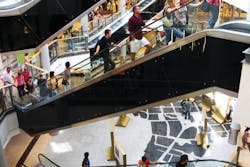Earlier this week, chaos erupted at the Garden State Plaza mall in N.J after a man armed with what appeared to be an assault rifle walked into the building and began firing shots at the ceiling. The gunman, identified as 20-year-old Richard Shoop, was later found dead of a self-inflicted wound. In September, as many as 15 gunmen affiliated with the Somali terror group al-Shabaab, an offshoot of al-Qaida, laid siege to the Westgate mall in Kenya over a three-day period, killing more than 60 people. And just days prior to the shooting massacre at Sandy Hook Elementary School last December, two people were killed and another person was wounded when 22-year-old Jacob Tyler Roberts opened fire at the Clackamas Town Center mall just outside Portland, Ore.
These incidents have prompted retailers across the country to review their security plans and examine areas where they might be vulnerable to an attack. As the busy holiday shopping season begins ramping up this month with the annual Black Friday sales event, ensuring the safety of patrons at stores both big and small is even more paramount.
According to King Rogers, who spent 18 years as the vice president of assets protection at Target and now serves as CEO of security management consulting firm the King Rogers Group, having partnerships with law enforcement authorities and training staff how to respond appropriately can go a long way in helping retailers mitigate the damages caused by an active shooter incident.
“Local law enforcement is always involved in an incident with an active shooter and therefore, local law enforcement, mall security and mall management ought to be involved in a collaborative effort for an incident training plan and implementing, through tabletop exercises, the practice of that training, so they know exactly what to do and when to respond,” Rogers explained. “Unfortunately, I think that the number of these types of incidents both in shopping centers and other commercial buildings appears to be increasing and it’s unfortunately going to evolve into a way of life for us and that’s why I think law enforcement and the private sector partnership is immensely important.”
Rogers said that drills should be held at least semi-annually and that mall management and security personnel should hold planning meetings with law enforcement on a quarterly basis.
Pat Murphy, president of Houston-based LPT Security Consulting, agrees that thorough training is key when it comes to preparing for the threat of an active shooter and also for the potential fallout after an incident has occurred.
“Liability is very high for failing to plan or having a plan and not determining if it works. Lawsuits will be filed before the smoke literally clears,” said Murphy, who formerly served as area loss prevention manager with Sears and as the director of loss prevention operations at Eckerd drug stores. “The question that malls must ask themselves is whether they have developed a defensible position for litigation. It is a backwards way to arrive at the question regarding planning, but ultimately, that is the view. No one guarantees safety. No plan guarantees prevailing in a lawsuit. Doing nothing is a guarantee of being found not providing reasonable care.”
Of course, Rogers said that U.S. malls could fortify themselves the way their counterparts do in Israel and parts of South America with heavily armed security personnel, but then we, as a nation, would lose a lot of the freedoms we’re accustomed to. However, Rogers said that a good audit program can help retailers evaluate the risks to their facilities and address any vulnerability the best that they can.
“Risk and vulnerability assessments should be done in every shopping center of any size throughout the United States,” said Rogers. “The U.S. media would like nothing better than to have some gun-toting nut come into a U.S. mall property and do damage. They would have a field day with issues of gun control and it allows them to sell more papers and airtime. I think that further erosion of mall traffic is going to be disastrous for the retail locations within these malls. Every mall location in the United States should undertake an audit program conducted by a third-party resource that knows what he or she is doing when it comes to physical security assessments.”
In an interview with SIW earlier this year, Mall of America Security Director Doug Reynolds said that awareness training for both mall staff and tenants can also make a difference.
“So often after these events when people are interviewed after the fact they say, ‘you know, yeah he seemed weird, I saw him, but I just didn’t want to call someone, I just didn’t think that it was necessary to call,’” Reynolds said. “If you make that threshold low enough and empower people to make those calls, I think it helps.”
In addition, Reynolds said that they hold lockdown drills at Mall of America in preparation for worst case scenarios.
“It’s a very short drill. The analogy we make is that it’s like fire drills. There isn’t a sixth grader in the United States that can’t do a fire drill, so we make it simple,” said Reynolds. “We sound tones to put people into lockdown, the tenants go into lockdown, they get people into their space, lock their gates, turn off lights, and get out of sight a little bit. When they get the all clear, they come out and the whole procedure takes less than 10 minutes.”
Rogers believes that most of the larger retailers across the country are certainly cognizant of the risks posed by active shooters and perhaps take them more seriously than many smaller stores, which don’t have the resources or the “sensitivity” within their culture to know how to develop a response and business continuity plan to get them back up and running in the aftermath of a mass shooting.
Once a mall has a plan in place, Rogers said that employees need to be trained on how they should respond.
“They need to understand the physical layout of the facility and where the cameras are,” Rogers explained. “They need to understand where the exits are, where the safe spots are and they need to understand the various steps that they need to take in an incident like this – what to do with cellphones, for example, if they’re not able to run to a safe place but instead have to hide and shut off their cellphone ringer. Employees also need to know how to help customers, but first and foremost, they have to protect themselves because if they’re too busy concentrating on trying to protect others because they believe that is what they are there to do, unfortunately all too often, they’re going to lose their life in an incident like this.”
When it comes to security personnel, however, Rogers said that their responsibilities differ from that of other retail employees.
“They’re really there to protect. They’re not sworn law enforcement, but they’re there to provide protection services for the mall and the people in the mall,” he said. “Therefore, as part of those protection services, they should be trained on how to safely get people out of the line of fire of the shooter and to a safe place. Security is an extension of law enforcement and they have to be aware that others are depending on them for their safety and therefore, they need to be trained on what to do and practice on what they have been trained.”
Editor’s note: SIW will be hosting a free, one-hour webinar on Nov. 14 at 1 p.m. ET on how the security team at Sacramento’s Arden Fair Mall is using video surveillance to improve their security posture. Click here for more information or to register.
About the Author
Joel Griffin
Editor-in-Chief, SecurityInfoWatch.com
Joel Griffin is the Editor-in-Chief of SecurityInfoWatch.com, a business-to-business news website published by Endeavor Business Media that covers all aspects of the physical security industry. Joel has covered the security industry since May 2008 when he first joined the site as assistant editor. Prior to SecurityInfoWatch, Joel worked as a staff reporter for two years at the Newton Citizen, a daily newspaper located in the suburban Atlanta city of Covington, Ga.

